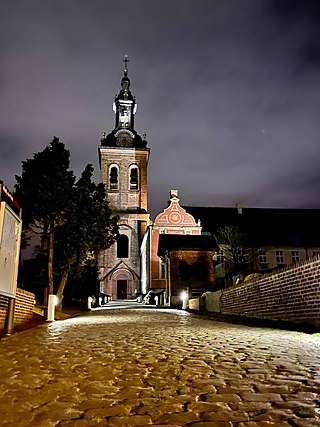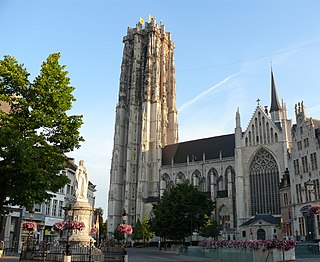
Malle is a municipality located in the Campine region of the Belgian province of Antwerp. The municipality comprises the villages of Oostmalle and Westmalle. In 2021, Malle had a total population of 15,620. The total area is 51.99 km2.

Dilbeek is a municipality in the province of Flemish Brabant, in the Flemish region of Belgium. The municipality comprises the villages of Dilbeek proper, Groot-Bijgaarden, Itterbeek, Schepdaal, Sint-Martens-Bodegem, and Sint-Ulriks-Kapelle. Dilbeek is located just outside the Brussels-Capital Region in the Pajottenland, hence the local name Poort van het Pajottenland.

Grimbergen is a municipality in the province of Flemish Brabant, in the Flemish region of Belgium, 10 km (6.2 mi) north of the capital Brussels. The municipality comprises the towns of Beigem, Grimbergen, Humbeek, and Strombeek-Bever. In 2017, Grimbergen had a total population of 37,030. The total area is 38.61 km2 (14.91 sq mi), which gives a population density of 959/km2 (2,480/sq mi).

Merchtem is a municipality located in the Belgian province of Flemish Brabant. The municipality comprises the villages of Brussegem and Hamme, the hamlets of Ossel and Peizegem, and Merchtem proper. On July 9, 2009, Merchtem had a total population of 15,298. The total area is 36.72 km2 which gives a population density of 416 inhabitants per km2.

Kortenberg is a Belgian municipality located in the province of Flemish Brabant, about halfway between the cities of Brussels and Leuven. The municipality comprises the subdivisions or deelgemeenten of Erps-Kwerps, Everberg, Kortenberg proper and Meerbeek. On 1 January 2013 Kortenberg had a total population of 19,393. The total area is 34.52 km2 which gives a population density of about 562 inhabitants per km2. In the southern part of Everberg there is also a hamlet called Vrebos, while between Erps-Kwerps and Meerbeek there is another hamlet called Schoonaarde, which can be found in the proximity of the train station of Erps-Kwerps.

Beauvechain is a municipality of Wallonia located in the province of Walloon Brabant, Belgium.

Wavre is a city and municipality of Wallonia, and the capital of the province of Walloon Brabant, Belgium.

Villers Abbey is a former Cistercian abbey located in the town of Villers-la-Ville, Walloon Brabant, Belgium. Founded in 1146, the abbey was abandoned in 1796. Most of the site has since fallen into ruins. These ruins now belong to the Walloon Region and are classified as part of Wallonia's Major Heritage.

Saint Gudula was born in the pagus of Brabant. According to her 11th-century biography, written by a monk of the abbey of Hautmont between 1048 and 1051, she was the daughter of a duke of Lotharingia called Witger and Amalberga of Maubeuge. She died between 680 and 714.

Bourne Abbey and the Parish Church of St. Peter and St. Paul is a scheduled Grade I church in Bourne, Lincolnshire, England. The building remains in parochial use, despite the 16th-century Dissolution, as the nave was used by the parish, probably from the time of the foundation of the abbey in 1138.

Affligem Abbey is a Benedictine abbey in the historic village of Hekelgem, now in the municipality of Affligem, Flemish Brabant, Belgium, 19 km (12 mi) to the north-west of Brussels. Dedicated in 1086, it was the most important monastery in the Duchy of Brabant and therefore often called Primaria Brabantiae.

The Duchy of Brabant, a state of the Holy Roman Empire, was established in 1183. It developed from the Landgraviate of Brabant of 1085–1183, and formed the heart of the historic Low Countries. The Duchy comprised part of the Burgundian Netherlands from 1430 and of the Habsburg Netherlands from 1482, until it was partitioned after the Dutch revolt of 1566–1648.

Averbode Abbey is a Premonstratensian abbey situated in Averbode, in the municipality Scherpenheuvel-Zichem, in the Archdiocese of Mechelen-Brussels in Belgium. It was founded about 1134, suppressed in 1797, and reestablished in 1834. Throughout the 20th century the abbey press was a leading children's publisher in Belgium. The church's building is a peculiar synthesis of Baroque and Gothic, with Renaissance ornament details, dominating the monastery complex. The whole structure was built of iron sandstone from Langdorp and white sandstone from Gobertange between 1664 and 1672, after a design by the Antwerp architect Jan Van den Eynde II.
Beek is a town and municipality in Limburg, Netherlands.

Park Abbey is a Premonstratensian abbey in Belgium, at Heverlee just south of Leuven, in Flemish Brabant.

Nizelles Abbey was an abbey of Cistercian monks located in Wallonia in Ophain-Bois-Seigneur-Isaac in Braine-l'Alleud, Walloon Brabant, Belgium, on a short distance to the south of Brussels.

The Archdiocese of Mechelen–Brussels is a Latin Church ecclesiastical territory or archdiocese of the Catholic Church in Belgium. It is the primatial see of Belgium and the centre of the ecclesiastical province governed by the Archbishop of Mechelen–Brussels, which covers the whole of Belgium. It was formed in 1559 and the bishop has a seat in two cathedrals, St. Rumbold's Cathedral in Mechelen and the Cathedral of St. Michael and St. Gudula in Brussels. The current archbishop is Luc Terlinden, who was installed in September 2023.

Fenix–Deceuninck is a women's professional road bicycle racing team based in Belgium, that was formed in 2020. It became a UCI Women's WorldTeam in 2023.

Valduc Abbey was a Cistercian monastery for nuns founded around 1232. It was located in Hamme-Mille, a district of the current Belgian municipality Beauvechain. Following the French Revolution it was secularised and in 1800 the buildings were sold off as building material and consequently demolished. In 1867 a brick château was erected on the spot of the former monastery.




















